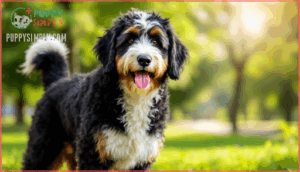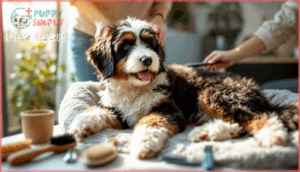This site is supported by our readers. We may earn a commission, at no cost to you, if you purchase through links.

A full-grown Bernedoodle displays striking variety in size, coat texture, and color patterns depending on their parents and generation. These dogs inherit the Bernese Mountain Dog’s gentle temperament and the Poodle’s intelligence.
Understanding what to expect as your puppy matures helps you prepare for their specific needs. Size determines everything from crate dimensions to food portions to potential health concerns.
Table Of Contents
- Key Takeaways
- What is a Full Grown Bernedoodle?
- Full Grown Bernedoodle Size Guide
- Appearance and Physical Features
- Health and Lifespan of Bernedoodles
- Temperament and Behavior Traits
- Care and Maintenance for Adults
- Frequently Asked Questions (FAQs)
- How big do standard Bernedoodles get when fully grown?
- What is the average lifespan of a Bernedoodle when properly cared for?
- How can you estimate the adult size of a Bernedoodle puppy?
- Are Bernedoodles prone to any specific health issues I should watch out for?
- Are Bernedoodles good with other pets?
- How much does a Bernedoodle puppy cost?
- Can Bernedoodles tolerate hot or cold weather?
- Do Bernedoodles bark excessively or often?
- Are Bernedoodles suitable for apartment living?
- Conclusion
Key Takeaways
- Bernedoodles grow dramatically from 15 pounds at eight weeks to 70-90 pounds (standard size) by age two, with four size categories ranging from petite (10-24 lbs) to standard (51-90 lbs) that determine everything from living space needs to potential health risks.
- Your Bernedoodle’s coat type—curly, wavy, or straight—directly affects shedding levels and grooming demands, with curly coats requiring daily brushing to prevent matting while offering the most hypoallergenic benefits.
- Smaller Bernedoodles live significantly longer than larger ones, with micro-minis reaching 16-18 years compared to standards at 12-15 years, and all sizes face genetic health risks including hip dysplasia, elbow dysplasia, and progressive retinal atrophy that warrant regular vet monitoring.
- These intelligent dogs inherit the Poodle’s trainability and the Bernese Mountain Dog’s gentle temperament, but their strong attachment to family means they need early socialization, consistent training, and strategies to prevent separation anxiety when left alone.
What is a Full Grown Bernedoodle?
A full grown Bernedoodle is a designer breed that combines the gentle strength of a Bernese Mountain Dog with the intelligence of a Poodle.
These dogs mature into loyal companions with varied sizes and appearances depending on their lineage.
Understanding their origins, personality, and coat characteristics helps you know what to expect as they reach adulthood.
Breed Origins and Generations
In 2003, Canadian breeder Sherry Rupke intentionally crossed the Bernese Mountain Dog with the Poodle to create the Bernedoodle. Her goal was straightforward: combine the Bernese’s gentle nature with the Poodle’s hypoallergenic coat and longer lifespan.
You’ll encounter different generation types of Bernedoodles—F1 Bernedoodle (50% each parent), F1b Bernedoodle (75% Poodle), and F2 Bernedoodle (two F1s crossed). Coat genetics shift with each generation, affecting shedding and curliness.
Bernedoodles are known for their affectionate and loyal personalities. Hybrid vigor and popularity factors stem from reduced health risks compared to purebred Bernese Mountain Dogs.
Typical Personality Traits
Your Bernedoodle’s personality often mirrors what you see in both parent breeds—gentle, smart, and wanting to be around people. Bernedoodle temperament traits lean toward affectionate and sociable, making them excellent family pets with strong therapy potential.
They generally greet strangers with enthusiasm rather than suspicion, so they won’t function as guard dogs. Separation anxiety can develop if left alone too long, as they thrive on companionship.
Common Coat Types and Colors
One look at a full-grown Bernedoodle tells you this isn’t a one-size-fits-all breed—coat types and colors vary as much as the dogs’ personalities do. Coat genetics determine whether your dog develops a curly, wavy, or straight coat, each with different grooming needs:
- Curly coats resist shedding but mat easily without daily brushing
- Wavy coats offer a balance between low shedding and manageable care
- Straight coats shed more but need less frequent grooming
Bernedoodle color variations include classic tri-color, phantom, sable, and parti patterns. Merle variations add unique mottled markings. Color fading often occurs as puppies mature.
Full Grown Bernedoodle Size Guide
One of the first things you’ll want to know is how big your Bernedoodle will get. Size varies quite a bit depending on the parents and generation.
Let’s break down the four main size categories and what influences how your dog grows.
Petite, Mini, Medium, and Standard Sizes
Four distinct size categories exist for full-grown Bernedoodles, each with specific weight and height ranges that help you predict what to expect when your puppy reaches adulthood.
Petite Bernedoodles weigh 10-24 pounds and stand under 14 inches tall. Mini Bernedoodles range from 26-35 pounds at 14-17 inches. Medium Bernedoodles weigh 36-50 pounds and stand 18-21 inches tall. Standard Bernedoodles are the largest at 51-90 pounds and 22-29 inches tall.
Your lifestyle and living space should guide which Bernedoodle size works best for you.
Factors Influencing Adult Size
What determines how large your Bernedoodle will actually grow? Poodle parentage plays the biggest role in Bernedoodle size, with toy, miniature, or standard variants directly shaping adult weight ranges. Bernese influence adds bulk and bone structure.
Generation impact matters too—F1b Bernedoodles with more Poodle genetics often stay smaller. Nutrition effects and growth rate during puppyhood also contribute to final size, though genetics set the foundation for Bernedoodle size variations you’ll see. These variations include the standard Bernedoodle size, which can weigh between 50-90 pounds.
Growth Milestones and Maturity
Most Bernedoodles reach their full height by 12 to 14 months, but their bodies continue filling out for several months after that. Standard Bernedoodles may not reach complete maturity until 18 to 24 months. You’ll notice size plateaus as growth stages progress, with behavioral changes and cognitive development continuing well into their second year.
- A 6-month-old puppy still growing rapidly with awkward proportions
- A 12-month adolescent at full height but still lanky
- An 18-month young adult with muscle definition emerging
- A 24-month fully mature dog with settled temperament
Appearance and Physical Features
When you see a full grown Bernedoodle, you’ll notice their appearance can vary quite a bit depending on their parents and generation. Their coat texture, color patterns, and physical build all contribute to their unique look.
Let’s break down the key physical features that define these dogs.
Coat Texture and Shedding
Your Bernedoodle’s coat can feel like anything from a soft cloud to a tight corkscrew, and that texture determines how much hair you’ll find on your couch. Curly coats shed minimally and work well for allergy concerns, while wavy types fall somewhere in the middle. Straight coats shed more noticeably and need different Bernedoodle coat care approaches.
| Coat Types | Shedding Levels | Grooming Needs |
|---|---|---|
| Curly | Minimal to none | Daily brushing, professional grooming every 6–8 weeks |
| Wavy | Light to moderate | Brushing 2–4 times weekly |
| Straight | Moderate | Brushing 2–4 times weekly, less frequent professional grooming |
Your dog’s coat may change texture as they mature from puppyhood into adulthood.
Color Variations
Tricolor patterns get all the attention, but Bernedoodles show up in a surprising palette—from solid black and phantom markings to rare merles and sables that can shift as your dog matures. Coat genetics from both parent breeds create endless combinations, and color fading happens frequently in darker Bernedoodle coat types as they age.
- Tricolor: Black base with white chest and rust markings (classic Bernese look)
- Phantom markings: Solid base with tan eyebrows, chest, and leg points
- Parti patterns: 50% white with patches of another color
- Merle variations: Mottled gray-blue patterns (less common, requires careful breeding)
- Solid colors: Black, chocolate, or apricot without white markings
Distinguishing Bernedoodle Features
Beyond the fluff and color, a full-grown Bernedoodle carries a few telltale signs that set it apart from other doodle mixes—and recognizing them helps you understand what you’re really getting. Look for expressive dark eyes, a broad snout that hints at Bernese heritage, and large paws that stay proportionally bigger than most Poodle crosses.
Their tails tend to curve gently rather than curl tightly, and unique markings often include white blazes or chest patches that make each Bernedoodle one of a kind.
Health and Lifespan of Bernedoodles
Your Bernedoodle’s health profile shapes how many years you’ll spend together. Like their parent breeds, these dogs face certain genetic risks that vary by size.
Let’s look at what conditions to watch for and how long you can expect your companion to be by your side.
Common Health Issues
Like a ticking clock, certain health conditions require your attention as your Bernedoodle ages. Hip Dysplasia and Elbow Dysplasia rank among the most frequently reported Bernedoodle health issues, causing joint pain and mobility challenges. Eye Problems deserve close monitoring too:
- Progressive Retinal Atrophy gradually reduces vision and can lead to blindness
- Hip Dysplasia creates painful joint deterioration in the hips
- Elbow Dysplasia affects front leg joints and gait
- Gastric Dilatation-Volvulus (GDV) is a life-threatening stomach condition requiring emergency care
- Allergies trigger skin irritation and recurring ear infections
Genetic Testing before breeding helps reduce inherited risks in your dog’s bloodline.
Lifespan by Size Category
Understanding Bernedoodle lifespan information starts with recognizing that size directly impacts how long your dog will live.
Standard Bernedoodles weighing 65–95 pounds usually live 12 to 15 years, while Mini Bernedoodles (20–60 pounds) average 14 to 17 years.
Tiny or Micro-Mini Bernedoodles show the longest lifespan at 16 to 18 years, thanks to their slower biological aging and reduced organ stress.
Temperament and Behavior Traits
Your Bernedoodle’s personality shapes daily life in ways that matter—from how they greet guests to how they cope with alone time.
Understanding their social needs, energy levels, and learning style helps you build a strong bond and prevent common behavioral issues.
Let’s look at what makes these dogs tick and how to bring out their best.
Socialization and Family Dynamics
From the moment your puppy steps into your home, early socialization shapes their entire future with your family. Well-socialized Bernedoodles thrive in homes with children and other pets, showing considerable patience and adaptability.
Their strong family bonds make them excellent emotional support companions, though this attachment means you’ll need to address separation anxiety through consistent routines and gradual alone-time training to prevent destructive behaviors.
Bernedoodles form deep family bonds that make them excellent emotional support companions, but their attachment requires consistent routines and gradual alone-time training to prevent separation anxiety
Exercise and Activity Needs
Your Bernedoodle’s physical energy mirrors their emotional needs—both require daily attention to keep them balanced and happy. Plan for 30 to 45 minutes of daily exercise through walks, fetch sessions, or swimming.
Mental stimulation matters just as much—puzzle toys and scent games prevent boredom. Activity levels shift with age and size, so you’ll adjust exercise intensity as your dog matures.
Training and Intelligence
Bernedoodles inherit sharp intelligence from their Poodle lineage, which makes them quick learners who pick up commands faster than many breeds. Positive reinforcement drives the best results in obedience training, while early socialization prevents anxiety later on.
Effective Bernedoodle training and behavior strategies include:
- Start basic commands and social exposure during puppyhood to build confidence
- Use puzzle toys and problem solving games for mental stimulation between training sessions
- Keep sessions short and reward-based—dog training works best when your Bernedoodle stays engaged
- Vary activities to challenge their high trainability and prevent boredom
Care and Maintenance for Adults
Caring for your full grown Bernedoodle means staying on top of a few key areas that keep them healthy and happy. Your dog’s needs will vary based on their size and coat type, but some basics apply to all adult Bernedoodles.
Let’s look at the essential care routines you’ll need to maintain.
Grooming and Coat Care
Proper grooming isn’t just about keeping your Bernedoodle looking their best—it’s essential for preventing painful mats, skin infections, and other health problems that can sneak up on you. Your Bernedoodle coat care routine depends heavily on what type of coat they inherited.
| Coat Type | Brushing Frequency |
|---|---|
| Curly | Daily |
| Wavy | 2-4 times weekly |
| Straight | 2-3 times weekly |
| All types | Professional grooming every 6-8 weeks |
Curly coats need daily coat brushing to prevent matting. Wavy and straight coats require less maintenance but still need regular attention. Professional grooming every six to eight weeks keeps shedding control manageable.
Bathing frequency should stay around every two to three months unless your dog gets dirty. Don’t forget nail trimming and ear cleaning at least weekly to round out your Bernedoodle grooming guide.
Diet and Nutrition
What you put in your dog’s bowl has a direct impact on everything from their coat shine to how many years you’ll get to share together. Choose dog food approved by AAFCO and match calorie requirements to your Bernedoodle’s size.
Feeding schedules depend on age—puppies need multiple meals while adults do well with two. Weight management matters since Bernedoodles gain pounds easily.
Dietary supplements supporting joint health can help, and fresh water should always be available to meet hydration needs.
Preventive Health and Vet Visits
Catching problems early—before symptoms show—can add years to your Bernedoodle’s life. Schedule annual vet visits to monitor for Bernedoodle health concerns like hip dysplasia and eye problems.
Keep vaccination schedules current and maintain parasite prevention year-round. Your vet will check dental hygiene and weight management while screening for genetic disorders.
Early detection of dog health issues makes treatment easier and more effective.
Frequently Asked Questions (FAQs)
How big do standard Bernedoodles get when fully grown?
Good things come in large packages—standard Bernedoodles usually weigh 51 to 90 pounds and stand 22 to 29 inches tall at the shoulder when fully grown. Though parental influence and individual growth timelines create natural size variation within breed standards.
What is the average lifespan of a Bernedoodle when properly cared for?
A Bernedoodle’s lifespan depends on its size. Standard Bernedoodles usually live 12-15 years. Mini and toy versions often reach 14-18 years, while micro-minis can live 16-18 years with proper preventative care and nutrition.
How can you estimate the adult size of a Bernedoodle puppy?
Your puppy’s parent size offers the best clue—standard Poodle or Bernese Mountain Dog parents produce larger offspring.
Paw size, breeder insight, and weight charts help track growth milestones, though genetics influence final size more than early predictions.
Are Bernedoodles prone to any specific health issues I should watch out for?
Yes, they can develop hip dysplasia, elbow dysplasia, and progressive retinal atrophy (PRA). Gastric dilatation-volvulus (GDV) and cancer risk also affect the breed.
Genetic testing helps identify potential genetic disorders before symptoms appear.
Are Bernedoodles good with other pets?
Most Bernedoodles get along well with other pets when properly socialized early. Their friendly Bernedoodle temperament makes them adaptable family pets.
However, supervision is needed during introductions to prevent resource guarding and manage any predatory instincts toward smaller animals.
How much does a Bernedoodle puppy cost?
Prices usually range from $2,000 to $5,000, depending on breeder reputation, location impact, size variation, and coat color preferences.
Hidden costs like initial vet visits and supplies add to your overall dog breed investment.
Can Bernedoodles tolerate hot or cold weather?
Their thick coat insulation manages cold well, but Bernedoodles struggle in heat. You’ll need paw protection in snow, frequent hydration breaks in summer, and activity modification during temperature extremes to manage their breed sensitivity.
Do Bernedoodles bark excessively or often?
While not naturally excessive barkers, Bernedoodles can develop barking habits triggered by boredom, separation anxiety, or lack of socialization.
Training solutions like positive reinforcement and early behavioral work help manage noise complaints and align with most owners’ tolerance for typical dog vocalizations.
Are Bernedoodles suitable for apartment living?
While smaller Bernedoodles can adapt to apartment living, they need daily exercise and mental stimulation. Space requirements depend on dog size. Noise levels stay manageable with proper socialization. Alone time tolerance varies, but these dogs thrive on interaction, making apartment life challenging without commitment.
Conclusion
That tiny puppy in your lap won’t fit there for long. The full grown Bernedoodle beside you now—whether a compact thirty pounds or a substantial ninety—represents years of careful nutrition, consistent training, and attentive health management. Your preparation determines their quality of life.
Size dictates space requirements. Temperament shapes daily routines. Coat type influences grooming schedules. These dogs thrive when their specific needs align with your lifestyle and commitment level. The bond you build starts with understanding exactly what you’re raising.
- https://www.wisconsindesignerdoodles.com/bernedoodle
- https://goldendoodles.net/bernedoodle-size-what-are-the-different-sizes-and-weights/
- https://fawnriverdoodles.com/article/bernedoodle-life-span/
- https://www.rover.com/blog/breeds/bernedoodle/
- https://www.bernedoodleworld.com/exercise-requirements-for-bernedoodles-too-much-or-not-enough/













